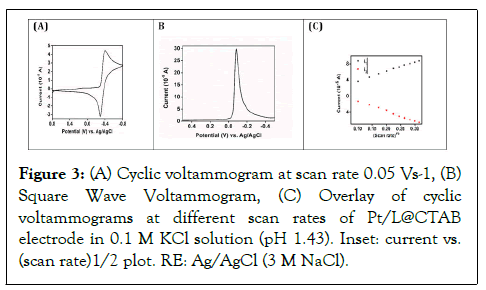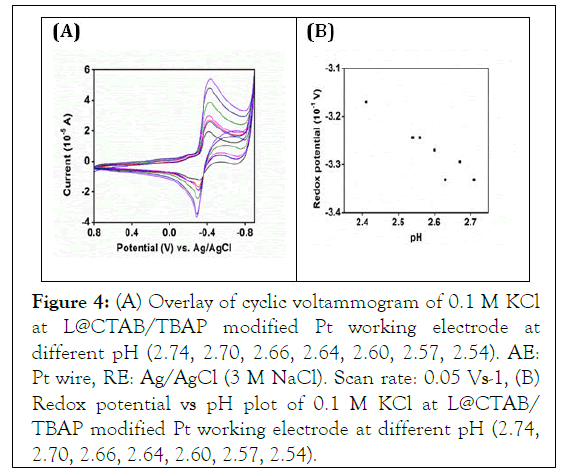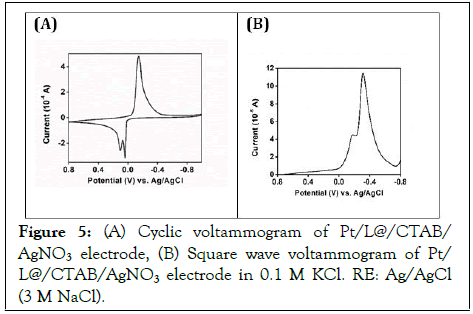Mass Spectrometry & Purification Techniques
Open Access
ISSN: 2469-9861
+44 1300 500008
ISSN: 2469-9861
+44 1300 500008
Research - (2022)Volume 8, Issue 2
Lawsone (2-hydroxy-1,4-naphthoquinone) is the main active chemical constituent of Henna (Lawsoniainermis). Lawsone encapsulated in cationic surfactant cetyltrimethyl ammonium bromide modified pre-cleaned platinum electrode, coated with AgNO3, showed a decrease in cathodic and anodic currents in cyclic voltammetry and the peak current in square wave voltammetry. Electrochemical Impedance Spectroscopy of the modified electrode showed a linear increase in charge transfer resistance with cholesterol. The fluorescence intensity of Lawsone in ethanol-water was found to quench in presence of AgNO3 which then gradually increased on addition of cholesterol. The electrochemical behaviour of the modified electrode and the fluorescence behaviour of Lawsone in presence of AgNO3 towards cholesterol was found to be similar in artificial cerebrospinal fluid, confirming that NaCl, NaHCO3, KCl, CaCl2, glucose and uric acid do not interfere with the detection of cholesterol. The limit of detection of cholesterol in 0.1 M KCl is 4.0 × 10-7 M and 7.76 × 10-8 M in synthetic cerebrospinal fluid.
Cholesterol; Lawsone; Voltammetry; Impedance; Fluorescence
Molecular recognition has become important in the fields of environmental pollution, medical diagnosis, etc. A change in a property of the probe molecule observable by various instrumental techniques upon interaction with the target molecule is the basic principle for molecular recognition. H- bonding are well exploited means of interaction between probe and the target [1-4]. Study of the change in redox potential and redox currents of the probe on its interaction with the target is well studied for qualitative and quantitative detection of the target [5].The basic principle of electrochemical biosensor is that chemical reactions between immobilized biomolecule and target analyte produce or consumes ions or electrons, which affects measurable electrical properties of the solution, such as electric current or potential [6]. Designing of modified electrodes for the detection of molecules and ions is a challenging problem which has good analytical applications in environmental chemistry, medicinal chemistry, etc.
Quinones are widespread in living organisms, performing a variety of biochemical and physiological functions. The biochemical functions of quinones are connected to a great extent with their ability to undergo reversible redox conversion and therefore the investigation of their electrochemical properties has aroused significant interest [7]. 2-Hydroxy -1 ,4- naphthoquinone (HNQ; Lawsone) is the principal natural dye contained at 1.0-1.4% (high proportion)in the leaves of Henna(Lawsonia inermis). The yellow pigment lawsone is contained in the leaves of the tropical bush Lawsoniainermis (henna plant). Henna has been used for more than 4000 years not only as a hair dye, but also as a body paint and tattoo dye. When henna is applied in a form of paste onto hair, skin or nail, it imparts a reddish-brown coloration lasting for up to twelve weeks. The green leaves paste has been used to prevent various infections such as ulcers, constipation, anemia, small pox and inflammation from ancient time[8,9].
Lawsone (2-hydroxy-1,4-naphthoquinone; red-orange dye; natural orange 6; slightly water soluble; simple molecule with non-ionic groups) is the main active chemical constituent of henna leaves that has an affinity towards protein binding, leading to a strong stain at ambient conditions and also used for dyeing in textile industries. Hydroxy naphthoquinone and its derivatives have strong coordination ability towards metal ions and act as redox active ligands. Kumar and hisco-workers used lawsone in the synthesis of azo dye and prepared a colorimetric sensor for the detection of copper (II) and iron(III) ions by using fluorescence spectroscopy.
It is reported that Lawsone shows well-defined cyclic voltammogram due to the reversible conversion of the two ketone groups into hydroxyls. The electrochemical activity (redox activity) of Lawsone is due to rapid reversible redox equilibrium between oxidized quinone form and reduced hydroquinone form. It is a two-electron redox process as shown in the Figures 1 and 2 below:
Figure 1: Two-electron reduction accompanied by proton transfer.
Figure 2: Successive one-electron reduction without proton transfer.
Naphthoquinones have many physiological roles, because some members of this group as ubiquinone, plastoquinone and K vitamins are key functional constituents of biochemical systems.
Cholesterol has a number of important functions in the human body. Cholesterol and its derivatives are the structural components of biological membranes as well as nerve and brain cells. Cholesterol is synthesized in the liver and also supplied from dietary intake. Besides it takes part in the production of steroid hormones, vitamin D, bile acids and other biologically active molecules. The disorder of cholesterol biosynthesis increases the risk of development of cardiovascular diseases and worsens the function of the immune system. High cholesterol level in blood is a marker of CVDs. Therefore, cholesterol determination techniques are necessary for clinical practice. Electrochemical techniques are widely spread in test systems and sensor construction. There are very few reported electrochemical methods for the detection of cholesterol.
There have been reports that Ag+ ions can interact with Lawsone as well as with cholesterol. Ag+ can form a strongly bound complex with Lawsone. Moreover, Zaheer et al. reported that Lawsone adsorption to a surface is much better in the presence of Ag+ ions and CTAB. Again, the presence of Ag+ causes a decrease in the blood cholesterol levels [10].
In this work we report that platinum working electrode when modified with lawsone (extracted from Lawsoniainermis) encapsulated in cetyltrimethylammoniumbromide and coated with AgNO3 acts as voltammetric and electrochemical impedance spectroscopic sensor for cholesterol. Aqueous solution of Lawsoniainermis and AgNO3 also shows significant emission wavelength shift on interaction with cholesterol.
Cetyl Trimethyl Ammonium Bromide (CTAB), Tetra Butyl Ammonium Perchlorate (TBAP), Cholesterol, Glucose, Urea, AgNO3, KCl, NaCl, CaCl2 and NaHCO3 are purchased from Merck and employed as received. The electrochemical measurements are done using CHI 660D CH electrochemical analyser (USA) consisting of a three-electrode system: bare or modified Pt electrode as the working electrode, Ag/AgCl (3 M NaCl) as the auxiliary electrode, Pt wire as the reference electrode and Tetra Butyl Ammonium Perchlorate (TBAP) or KCl as the supporting electrolyte. The fluorescence spectra are recorded in Hitachi F-7000 Fluorescence Spectrophotometer using quartz cuvette (1 cm path length).
Extraction of lawsone (L) from lawsoniainermis (Henna)
The fresh leaves of Lawsoniainermis (henna plant) were dried at room temperature for 7daysand then crushed into powder form. Lawsoniainermis powder was mixed with ethanol and left for a week. Then the mixture was filtered and Lawsone was extracted by means of the rotary evaporator. The residue left is used for further experiments. Lincorporated CTAB (L@CTAB) film on Pt electrode is prepared by dissolving 0.1 g CTAB, 0.1 g TBAP as supporting electrolyte and 0.5 g extracted L in 10 mL absolute alcohol. Then the mixture was stirred for 1 hour and the suspension was filtered. 40 μL of the solution was then placed on the tip of a pre-cleaned Pt electrode surface using Hamilton micro syringe. The solvent was allowed to evaporate resulting in the formation of Lencapsulated CTAB film on the electrode surface. The fabricated electrode will be designated as Pt/ L@CTAB working electrode. Cyclic voltammo grams were recorded by immersing the tip of this modified electrode in 0.1 M KCl aqueous solution.
Preparation of cholesterol solution
0.1 M Cholesterol solution was prepared by dissolving 0.387 g of cholesterol in 10 mL absolute alcohol.
Preparation of Pt/L@CTAB/AgNO3 electrode
The tip of Pt/L@CTAB electrode was dipped in saturated aq. AgNO3 solution for 1 hour and allowed to dry naturally. The resulting electrodedesignated as Pt/L@CTAB/AgNO3 was used as cholesterol sensor.
Preparation of synthetic cerebrospinal fluid
0.1 mg urea, 2.8 mg KCl, 3.2 mg CaCl2, 8 mg glucose, 16 mg NaHCO3 and 84 mg NaCl are mixed into 10 mL aqueous solution to prepare the synthetic cerebrospinal fluid.
Figure 3A shows the cyclic voltammograms of Pt/L@CTAB electrode in water in presence of 0.1 M KCl as supporting electrolyte at scan rate 0.05 Vs-1 versus Ag/AgCl (3 MNaCl) as reference electrode. A quasi-reversible redox couple with redox potential value E1/2=-0.348 V was observed with ΔE=0.110V. Figure 3B shows the square wave voltammograms of Pt/ L@CTAB modified electrode in water in presence of 0.1 M KCl as supporting electrolyte having similar redox potential value at -0.314 V. Figure 3C shows that with the increasing scan rates both the cathodic and anodic currents of the reversible redox couple increase. The cathodic and anodic currents are found to increase linearly with scan rates (Figure 3C, inset) which is a characteristic of surface adsorption and supports the formation of film on electrode surface.

Figure 3: (A) Cyclic voltammogram at scan rate 0.05 Vs-1, (B) Square Wave Voltammogram, (C) Overlay of cyclic voltammograms at different scan rates of Pt/L@CTAB electrode in 0.1 M KCl solution (pH 1.43). Inset: current vs. (scan rate)1/2 plot. RE: Ag/AgCl (3 M NaCl).
Cyclic voltammetric experiments are done at different pH (2.74, 2.70, 2.66, 2.64, 2.60, 2.57, 2.54) at L@CTAB/TBAP modified Pt working electrode. The cathodic and anodic peak currents are found to increase with decreasing pH which indicates that the redox process becomes faster on decreasing pH (Figures 4A and 4B).

Figure 4: (A) Overlay of cyclic voltammogram of 0.1 M KCl at L@CTAB/TBAP modified Pt working electrode at different pH (2.74, 2.70, 2.66, 2.64, 2.60, 2.57, 2.54). AE: Pt wire, RE: Ag/AgCl (3 M NaCl). Scan rate: 0.05 Vs-1, (B) Redox potential vs pH plot of 0.1 M KCl at L@CTAB/ TBAP modified Pt working electrode at different pH (2.74, 2.70, 2.66, 2.64, 2.60, 2.57, 2.54).
Figures 5A and 5B shows the cyclic voltammogram and square wave voltammogram of Pt/L@CTAB/AgNO3 in aqueous 0.1 M KCl. In cyclic voltammogram one sharp reduction peak was observed at -0.147 V versus Ag/AgCl while two sharp closely spaced peaks were observed for the oxidation process. In square wave voltammogram experiment only one sharp peak was observed at -0.084 V versus Ag/AgCl (3 M NaCl).

Figure 5: (A) Cyclic voltammogram of Pt/L@/CTAB/ AgNO3 electrode, (B) Square wave voltammogram of Pt/ L@/CTAB/AgNO3 electrode in 0.1 M KCl. RE: Ag/AgCl (3 M NaCl).
A probable explanation for the decrease in reduction and oxidation current without any change in peak positions with cholesterol concentration may be due to the formation of an electro-inactive adduct between silver salt of lawsone and cholesterol through hydrogen bonding. An alternative explanation may be that, when cholesterol is added gradually to the solution, the conductivity of the electrode surface decreases. This may be caused due to the deposition of material onto the electrode surface, thereby increasing the resistance and decreasing the current.
The interaction between cholesterol and Lawsone/AgNO3 solution was further verified by fluorescence studies. The Lawsonein ethanol solution shows fluorescence emission maxima at 680 nm when excited with 604 nm photons. Upon addition of aqueous AgNO3 solution, the fluorescence of Lawsonequenches. Gradual addition of cholesterol solution to this mixture shows an enhancement in the fluorescence intensity accompanied by a small blue shift to 676 nm.
Voltammetry and impedance spectroscopy in synthetic cerebrospinal fluid: Study of interference from other ions and molecules
Cyclic voltammogram, square wave voltammogram and Nyquist plots are measured for the modified electrodes versus cholesterol concentration in presence of synthetic cerebrospinal fluid. The recorded cyclic voltammogram, square wave voltammogram and Nyquist plots were similar to those when recorded with cholesterol alone.
Lawsone encapsulated CTAB modified platinum disc electrode when coated with AgNO3 can detect cholesterol by voltammetry and impedance spectroscopy. The voltammetric currents and charge transfer resistance decrease with cholesterol concentration. The ethanol-water solution of lawsone with AgNO3 found to show fluorescence enhancement with cholesterol. The voltammetric sensing of cholesterol was also proved in artificial cerebrospinal solution. The limit of detection of cholesterol in 0.1 M KCl is 4.0 × 10-7 M and 7.76 × 10-8 M in synthetic cerebrospinal fluid.
The authors thank DST, New Delhi for the MRP under SERB No. EMR/2016/001745 and ASTEC, Guwahati for financial support. DST is also thanked for financial support to the department of Chemistry, GU through FIST program.
The authors declare that there is no conflict of interest.
[Crossref] [Google Scholar] [PubMed]
[Crossref] [Google Scholar] [PubMed]
[Crossref] [Google Scholar] [PubMed]
[Crossref] [Google Scholar] [PubMed]
[Crossref] [Google Scholar] [PubMed]
[Crossref] [Google Scholar] [PubMed]
[Crossref] [Google Scholar] [PubMed]
[Crossref] [Google Scholar] [PubMed]
[Crossref] [Google Scholar] [PubMed]
Citation: Bhattacharjya R, Bordoloi P, Das DK (2022) Cetyltrimethyl Ammonium Bromide Encapsulated Lawsone Modified Platinum Electrode as a Voltammetric and Electrochemical Impedance Spectroscopy Sensor for Cholesterol. J Mass Spectrom Purif Tech. 8:149.
Received: 24-Mar-2022, Manuscript No. MSO-22-17004; Editor assigned: 28-Mar-2022, Pre QC No. MSO-22-17004; Reviewed: 14-Apr-2022, QC No. MSO-22-17004; Revised: 22-Apr-2022, Manuscript No. MSO-22-17004; Published: 02-May-2022 , DOI: 10.35248/2469-9861.22.8.149
Copyright: © 2022 Bhattacharjya R, et al. This is an open-access article distributed under the terms of the Creative Commons Attribution License, which permits unrestricted use, distribution, and reproduction in any medium, provided the original author and source are credited.